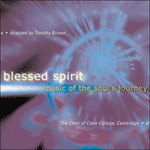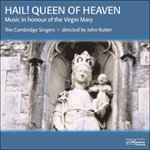A rather more positive view of Tchaikosvky’s sacred music than that of the Church was taken by Tsar Aleksandr III (1881–1894). He told the composer that he was puzzled at his not having written anything further in this field. Between November 1884 and April 1885, therefore, Tchaikovsky composed three further settings of the Cherubic Hymn, all similar in mood to that found in the complete Liturgy but much more influenced by chant and transparently modal. He also set a series of other sacred texts, three of them from the Liturgy (
Tebe poem,
Dostoyno est and The Lord’s Prayer); the magnificent, light-filled
Blazhenni yazhe izbral comes from the
Panikhidaÿ (funeral service),
Da ispravitsya is from Vespers, and
Nyne sily nebesnyya, in which the richness of Tchaikovsky’s scoring takes him close to Rachmaninov or Kastalsky, is from the Liturgy of the Presanctified.
from notes by Ivan Moody © 1997
Le tsar Alexandre III (1881–1894) considéra la musique sacrée de Tchaïkovski de manière plus positive que l’Église et dit au compositeur combien il était étonné qu’il n’eût rien écrit d’autre dans ce domaine. Entre novembre 1884 et avril 1885, Tchaïkovski composa donc trois autres mises en musique de l’Hymne chérubique, toutes d’humeur comparable à celle de l’ensemble de la Liturgie, mais beaucoup plus influencées par le chant grégorien et clairement modales. Il mit aussi en musique une série d’autres textes sacrés, dont trois provenant de la Liturgie (
Tebe poem,
Dostoyno est, Prière du Seigneur); citons également le magnifique
Blazhenni yazhe izbral, morceau empli de lumière, extrait du
Panikhidaÿ (service funèbre);
Da ispravitsya, tiré des vêpres; et
Nyne sily nebesnyya—dont la richesse d’écriture rapproche Tchaïkovski de Rachmaninov ou de Kastalski—, extrait de la liturgie des présanctifiés.
extrait des notes rédigées par Ivan Moody © 1997
Français: Hypérion
Eine etwas positivere Haltung gegenüber Tschaikowskys Kirchenmusik als die Kirche nahm Zar Alexander III (1881–1894) ein. Dieser äußerte dem Komponisten gegenüber seine Überraschung angesichts der Tatsache, daß er keine weiteren Werke auf diesem Gebiet geschrieben hatte. Zwischen November 1884 und April 1885 komponierte Tschaikowsky daher drei weitere Vertonungen des Cherubinischen Lobgesangs, dessen Stimmung jener in der kompletten Liturgie ähnlich ist, jedoch einen viel stärkeren Einfluß des Chorgesangs und eine transparente Modalität besitzt. Er vertonte außerdem eine ganze Serie von Kirchentexten, drei davon aus der Liturgie (
Tebe poem,
Dostoyno est,
Vaterunser), das herrliche, lichterfüllte
Blazhenni yazhe izbral stammt aus dem
Panikhidaÿ (Begräbnisgottesdienst),
Da ispravitsya aus der Vesper und
Nyne sily nebesnyya, in dem Tschaikowsky mit der Völle seiner Komposition nahe an Rachmaninow oder Kastalsky herangkommt, aus der Liturgie der vorgeweihten Gaben.
aus dem Begleittext von Ivan Moody © 1997
Deutsch: Anke Vogelhuber


 Blessed spirit
Blessed spirit Hail! Queen of Heaven
Hail! Queen of Heaven
